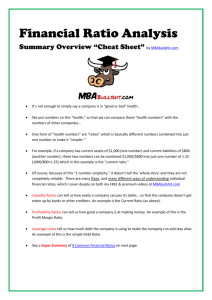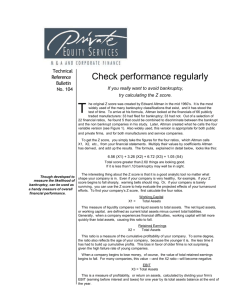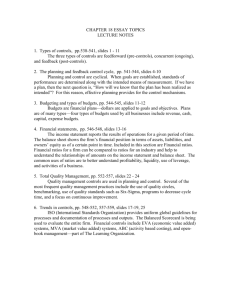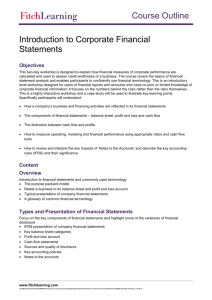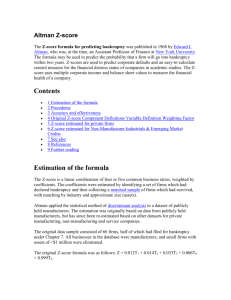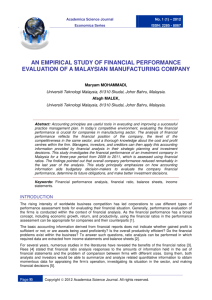Ratios - Fasset
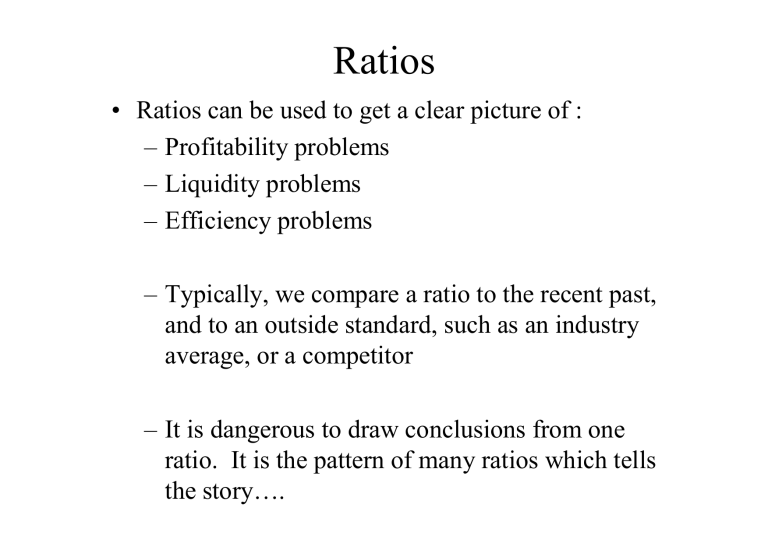
Ratios
• Ratios can be used to get a clear picture of :
– Profitability problems
– Liquidity problems
– Efficiency problems
– Typically, we compare a ratio to the recent past, and to an outside standard, such as an industry average, or a competitor
– It is dangerous to draw conclusions from one ratio. It is the pattern of many ratios which tells the story….
Searching for relationships
• Since there is no “bankruptcy risk” ratio,
Altman did a statistical test on many ratios to search for the ones which had the highest correlation with a bankruptcy within the following 2 years
• Most ratios had no clear relation, but a combination of 5 passed the test. These 5 are NEGATIVELY related to distress.
Z-score model
• Uses five financial ratios
• Ratios are objectively weighed and summed
• Ratios can be obtained from corporations financial statements
Z = 1.2X1 + 1.4X2 + 3.3X3 + 0.6X4 + 1.0X5
X1 = Working Capital/total assets
X2 = Retained Earnings/total assets
X3 = Earnings before interest and taxes/total assets
X4 = Market value equity/book value of total liabilities
X5 = Sales/total assets
Z = Overall index
The Z-score Model
• First developed by Altman in 1968
• Uses a specified set of financial ratios as variables in multidiscriminant statistical methodology (MDR)
• Real world application of the Altman score successfully predicted 72% of bankruptcies
2 years prior to their filing for Chapter 7 and 94% of bankruptcies 1 year prior to filing.
Z-score constituent ratios
• Working Capital/total assets (WC/TA)
– Working Capital is the difference between the current assets and current liabilities as obtained from the balance sheet
• Retained Earnings/total assets ( RE/TA)
– Retained Earning is also know as the earned surplus
– It represents the total amount of reinvested earnings and/or losses of a firm over its entire life-cycle
– Can be obtained from balance sheet
• Earnings before interest and taxes/Total assets (EBIT/TA)
– Measure of a corporation’s earning power from ongoing operations
– Also know as Operating profit
– Watched closely by creditors as it represent the total amount of cash that a corporation can use to pay off its creditors
– Can be obtained for the Income statement
Z-score constituent ratios
Continued…
• Market Value of Equity/Book Value of total liabilities (MVE/TL)
– The market value of equity is the total market value of all of the stock, both preferred and common
– The book value of liabilities is the total value of liabilities both long term and current
– The MVE/TL shows how much the firms assets can decline in value with increasing liabilities, before the liabilities exceed the assets
• Sales/Total Assets (s/TA)
– Also known as capital turnover ratio
– Illustrates the sales generating ability of the corporation’s assets
Z score Results
• Based on Z-scores averaged over time, Altman calculated that a Z-score of:
• 3.0 or more: Most likely safe based on the financial data.
Mismanagement, fraud, economic downturns, and other factors may cause an unexpected reversal.
• 2.8 to 3.0: Probably safe to predict survival, but this is a portion of the gray area and is below the threshold of relative safety.
• 1.8 to 2.7: Likely to be bankrupt within two years. This is the lower portion of the gray area and dramatic action may be required.
• Below 1.8: Highly likely headed for bankruptcy. Rarely would a firm be expected to recover from a financial condition generating this or lower scores.
Ratios Summary
• A lone ratio doesn’t tell us much
• An “improved” ratio doesn’t benefit everyone. (e.g. creditors love increased liquidity…who might not?)
• Managers are still looking for better ways to measure the sources of value, risk and control
• Managers need to become detectives – or hire detectives! (Fraud exposure rectangle)
